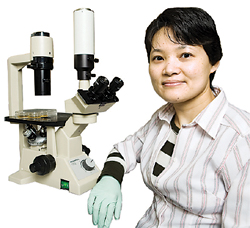Chinese scientists among research team
(China Daily)
Updated: 2007-11-22 10:18
Updated: 2007-11-22 10:18
Some Chinese scientists were among the University of Wisconsin-Madison's skin cell research team which reported their findings on Tuesday.
 Yu Junying [File photo]
|
Yu Junying, an assistant scientist, is the lead author of a paper describing a novel method of reprogramming adult stem cells to create cells that are indistinguishable from embryonic stem cells.
The breakthrough is actually a new start, for "it will open a new stage for humankind to utilize cells in studies at a larger scale," Yu told the Beijing-based Legal Evening News.
Yu was born in the city of Zhuji, Zhejiang Province. A Peking University graduate, she went to study abroad in 1997 and got her doctor's degree in the University of Pennsylvania in 2003.
In the same year, she joined the University of Wisconsin-Madison Primate Research Center.
There are also other Chinese researchers working in her group, said Yu.
Stem cells created without embryos
Researchers have transformed ordinary human skin cells into batches of cells that look and act like embryonic stem cells - but without using cloning technology and without making embryos.
Their breakthroughs, reported on Tuesday, could make possible the long-sought goal of tailor-made medicine, but without the political, scientific and ethical roadblock of using human eggs or embryos.
"We can now envisage a time when a simple approach can be used to produce stem cells that are able to form any tissue from a small sample taken from any of us," said Ian Wilmut of the University of Edinburgh, who helped clone the first mammal, Dolly the sheep, in 1997.
The White House immediately welcomed the development, given President George W. Bush's long opposition to embryo research, even as scientists said the finding should not be the end of such research.
Two separate teams of researchers achieved the same goal, which doctors hope someday will lead to tailored medical treatments and a new approach called regenerative medicine, in which damaged organs can be re-programmed to repair themselves.
The researchers agree it will be years before the technique could be used to treat people. More immediately, they say it can be used to study diseases and to screen drugs.
James Thomson of the University of Wisconsin in Madison and colleagues reported their finding in the journal Science. Shinya Yamanaka of Kyoto University in Japan and colleagues reported theirs in the journal Cell.
The new cells are called induced pluripotent stem cells and look and act like embryonic stem cells - the master cells that give rise to every cell and tissue in the body.
Both teams used just four genes to transform ordinary skin cells called fibroblasts into induced pluripotent stem cells - iPS cells for short.
"These cells should be useful in understanding disease mechanisms, searching for effective and safe drugs, and treating patients with cell therapy," Yamanaka said in a statement. His team got the cells to develop into heart cells, which then beat in unison.
"This work represents a tremendous scientific milestone - the biological equivalent of the Wright Brothers' first airplane," said Dr. Robert Lanza of Advanced Cell Technology, a company working in the same field.
"It's not practical to use right now, but it might be in a few years. This is truly the Holy Grail - to be able to take a few cells from a patient - say a cheek swab or few skin cells - and turn them into stem cells in the laboratory."
Yamanaka had first transformed mouse skin cells using four genes, and then tried his method on human cells. Thomson, whose team first discovered human embryonic stem cells in 1998, went straight to human cells using two of the same genes and two different genes. Each method is likely to be patented separately.
Both teams said the new cells are not ready to use in people yet because they used a type of virus called a retrovirus to carry the new genes into the skin cells. It is not clear whether this virus might cause genetic mutations that could cause cancer or other side effects.
(Agencies)
|
|
|
||
|
||
|
|
|
|